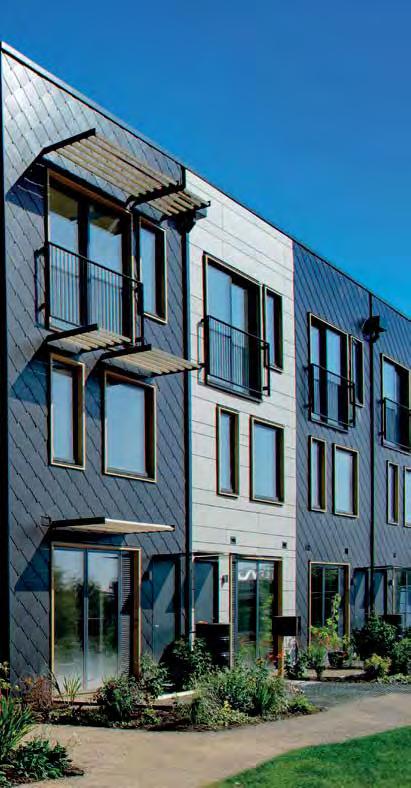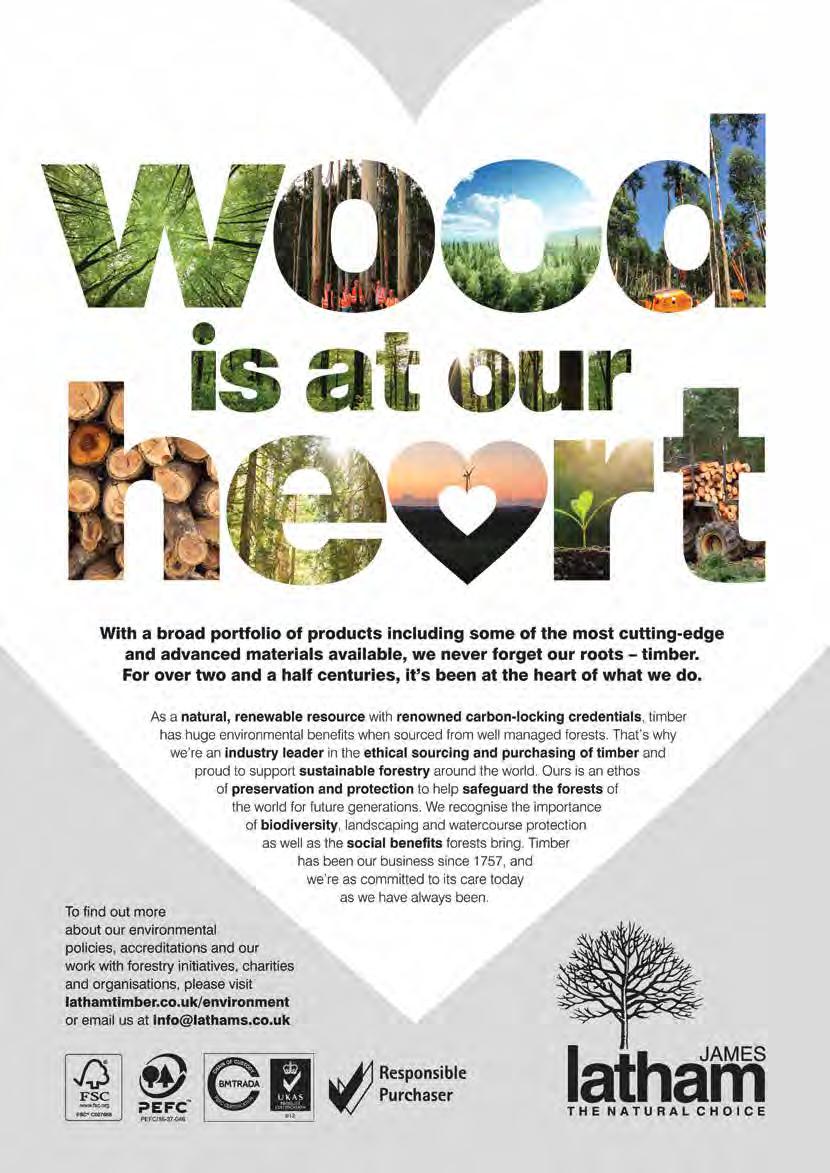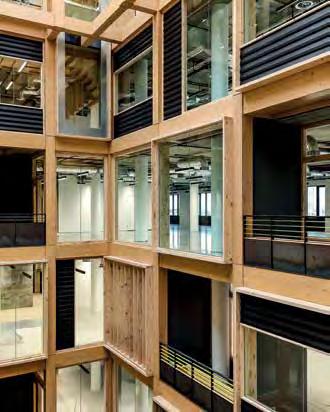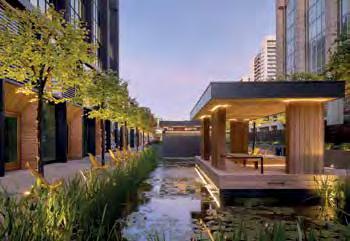
6 minute read
Why wood costs less: the path to net zero
Sarah Virgo calculates the sustainability savings that can be made through timber construction.
Solar Avenue, Climate Innovation District. Photo: Citu
Advertisement

In an attempt to slow climate change, the Government has set targets for the UK to reach net zero by 2050.1 If we are to have any realistic chance of reaching these goals in time, we must act now.
While there is no quick fix to addressing the climate emergency, the forest and wood-based industries have a crucial role to play. For the UK to reach net zero, we must prioritise and promote increased tree planting and greater use of wood products.
Indeed, in its 2019 UK housing: Fit for the future? report,2 the Committee on Climate Change said:
It also stated that the construction industry must focus on the whole-life carbon impact of new homes, including embodied and sequestered carbon.
How timber can achieve net zero
Using timber in construction helps to reduce carbon dioxide (CO2) levels in the atmosphere and slows climate change in three simple ways:
• Trees capture harmful CO2 from the atmosphere and store it as carbon. • Sustainable forest management with timely harvesting and restocking leads to continued capture of CO2. • Using timber for construction instead of more CO2 -intensive materials means carbon is stored for at least the lifetime of the building, and often longer when reclaimed wood is used for
According to the Institute of Structural Engineers, embodied carbon can contribute 10% to 20% of a building’s total carbon footprint.3 In a typical new office building, 50% of the embodied carbon is in the structure alone. This can be reduced by choosing timber for a building’s structure. >>

Embodied, operational and sequestered carbon
Embodied carbon, also known as embedded carbon or carbon capital, is defined by the UK Green Building Council as ‘the total greenhouse gas emissions generated to produce a built asset’.4 This means knowing how much CO2 is emitted from extraction, processing, manufacturing, transportation and assembly of every building product used.
Operational carbon is often measured alongside embodied carbon. It is the collective CO2 emissions produced for a building to run, from the energy, heating, cooling and ventilation systems through to IT equipment and lighting.4
Sequestered carbon is the amount of CO2 that is stored in the earth, in oceans, in trees and in plants. Trees ‘capture’ carbon during photosynthesis as they grow and this remains stored inside them even when they are felled and turned into wood products and materials. This means that buildings become a carbon store when their structural frame, insulation and interiors are made from wood.

Republic at East India Dock, Import Building. Photo: Dirk Lindner
One example is at Republic in East India Dock.5 Two office buildings, the Import Building and the Export Building were extended and refurbished together with the surrounding public realm. Architect Studio RHE worked with structural engineers Heyne Tillett Steel to expand both buildings with internal timber frame structures constructed from exposed glued laminated timber and cross-laminated timber (CLT).
The carbon stored in the new structures equates to 404 tonnes at the Export Building and 460 tonnes at the Import Building. This means that for the buildings’ lifetimes until demolition, the new structures store more than 1.5 times carbon than used in their construction.5 Ways to reduce embodied carbon include:
• specifying natural and renewable materials such as timber, particularly for the structure • specifying alternatives to cement mix such as lime and fly ash • checking the Environmental Product Declarations (EPDs) of a product for details on its carbon footprint (wood products can be checked using the Lifecycle Database)6 • using off-site construction to minimise waste, reduce build time and improve quality • applying circular economy thinking, particularly reusing materials or using fewer materials. This is key for the end of a building’s life.

The challenge of reducing operational carbon
When we think about creating more energy-efficient, environmentally friendly buildings, we often focus on switching to renewable energy sources. Although this is one part of the solution, if we continue to build poorly insulated and ventilated homes, the demand on renewable energy sources to heat and cool them will in itself be unsustainable. Homes also need to be as fabric efficient as possible.
To become more fabric efficient, Passivhaus principles are a good place to start. By designing airtight homes to Passivhaus or near-Passivhaus standards, houses are naturally heated and ventilated using air and ground source heat pumps and mechanical ventilation systems. >>
Republic at East India Dock, Export Building. Photo: Dirk Lindner

Passivhaus is not just for self-builders, as demonstrated by the RIBA 2019 Stirling Prize winning Goldsmith Street.7 Architect Mikhail Riches designed a mix of houses and flats for this Norwich City Council social housing development. Constructed from insulated timber frame panels that were manufactured off site, the homes were built to Passivhaus standards, with the result that the occupants enjoy sunny, light-filled homes and fuel bills of just £150 per year.
Another award-winning example is the Leeds Climate Innovation District.8 Designed by White Arkitekter and developed by sustainable property company Citu, it combines sustainable design and construction techniques to deliver low-carbon living for city-centre residents. The properties are ten times more airtight than UK Building Regulations require, coming close to Passivhaus standards.
Why wood CO2ts less
Those working in the built environment are aware of the impact the construction industry has on the planet. Drawing on limited resources, labour-intensive practices and creating buildings that are high in embodied and operational carbon are having longterm effects. Therefore, opting for more sustainable building materials that capture and store carbon, such as wood, needs to become normal practice. A report published by the BioComposites Centre at Bangor University concluded that using timber frames rather than masonry can reduce carbon embodied emissions by around 20% per building.9 When CLT is chosen in place of concrete structures the effect is even greater, with carbon embodied emissions reduced by around 60%.
As an industry, we already have the technology, knowledge and skills to make a dramatic difference to the impact that the built environment has on climate change. While the move will not always be easy, the negative impacts of doing nothing, adapting too slowly or merely tinkering around the edges will remain with us for generations to come. n
About the author
Sarah Virgo Campaign Manager Wood for Good
Further information
Wood for Good is the timber industry’s campaign to promote the use of wood in design and construction. For more information, visit www.woodforgood.com and sign up for the regular e-newsletter.
Further reading
To find out more about timber and sustainability, visit www.trada.co.uk/sustainability
References
1. www.gov.uk/government/news/uk-becomes-first-majoreconomy-to-pass-net-zero-emissions-law 2. https://d423d1558e1d71897434.b-cdn.net/wp-content/ uploads/2019/02/UK-housing-Fit-for-the-future-CCC-2019.pdf 3. www.istructe.org/resources/guidance/carbon-embodiedoperational 4. www.ukgbc.org/wp-content/uploads/2017/09/UK-GBC-EC-
Developing-Client-Brief.pdf 5. https://woodforgood.com/case-studies/republic-at-eastindia-dock 6. https://woodforgood.com/lifecycle-database 7. https://woodforgood.com/case-studies/goldsmith-street 8. https://woodforgood.com/case-studies/climate-innovationdistrict-leeds-city-centre 9. www.theccc.org.uk/publication/wood-in-construction-in-the-ukan-analysis-of-carbon-abatement-potential-biocomposites-centre










